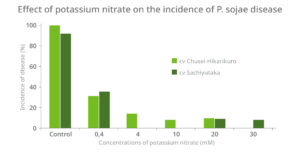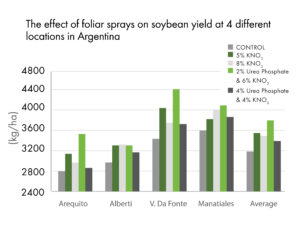On behalf of the Potassium Nitrate Association (PNA), Landlab research company in Italy conducted a trial to study the effect of potassium nitrate (PN) based foliar applications on soybean growth and yield parameters. In this article, the focus will be on soybean yield only.
Trial set up
The effect of the treatments was tested in a completely randomized design with two factors:
1. Foliar treatments (Table 1).
2. K dose rate in basal dressing with KCl (Table 2).
In total, the trial consisted of 80 plots (4 K dose rates x 4 foliar treatments x 5 replicates). Plot size was 2,0 m x 1,5 m = 3,0 m².
Sowing of soybean with Rhizobium inoculum was carried out on the 27th of May 2015. Harvesting was done on the 20th of October 2015.
Foliar treatments were applied two times: at the growth stages V3 (Third node, 29th of June) and R3 (Beginning pod development, 28th of July 2015). Foliar application was done plot by plot at a spray volume of 600 l/ha.
Results
The average soybean yield was 4,5 ton/ha, which is in line with the soybean potential of the area.
Main effects on total yield were found for both the foliar treatments and for the K dose rate in basal dressing. No statistically significant interaction (P=0,05) was found between the trial factors foliar treatments and basal dressing K dose.
Soybean yield was increased with 5% - 12% by two applications of the foliar PN based sprays, compared to the not foliar treated control. Foliar spray application of potassium nitrate (without addition of P source) resulted in the greatest statistically significant yield increase of 12%, followed by PN+MAP with 10% yield increase (Table 1).
Table 1. The effect of various foliar spray applications with potassium nitrate on soybean yield (MT/ha).
*) PN = potassium nitrate; MAP = monoammonium phosphate; UP = urea phosphate.
**) Means followed by the letter same are not statistically significantly different (Fisher’s protected least significant difference test at 5% level).
Increasing K dose in the basal dressing had a positive effect on soybean yield. Yield was statistically significantly higher (20% - 30%) at all doses of K compared to no KCl application in the basal dressing (Table 2).
Table 2. The effect of increasing dose rates of K applied as KCl in basal dressing on soybean yield.
*) Means followed by the letter same are not statistically significantly different (Fisher’s protected least significant difference test at 5% level).



